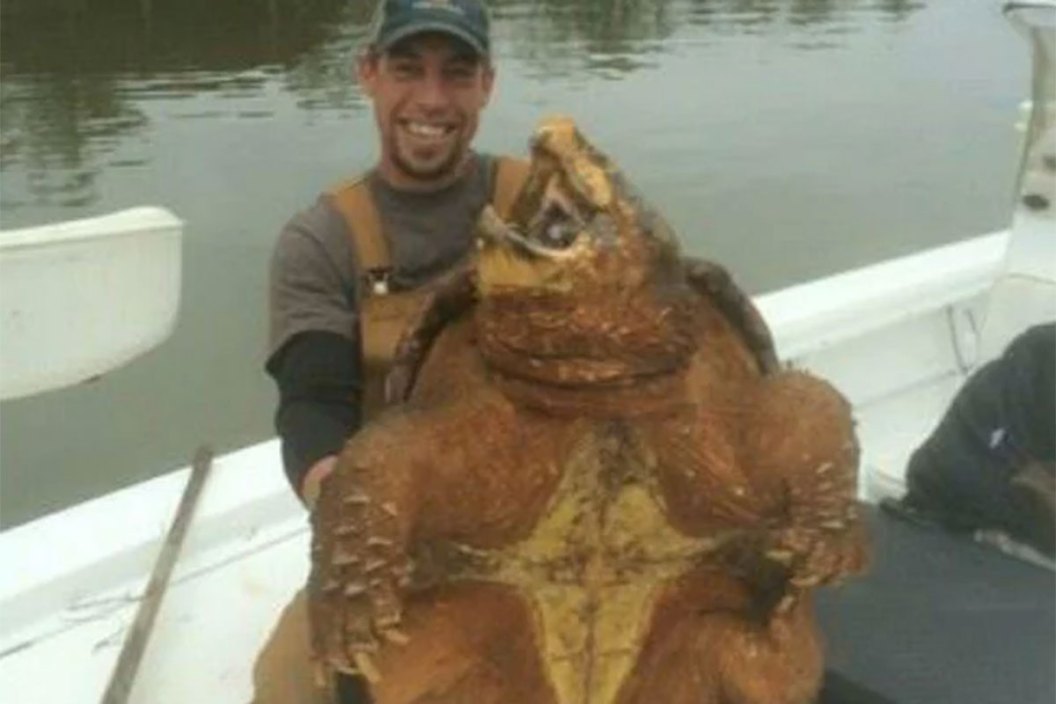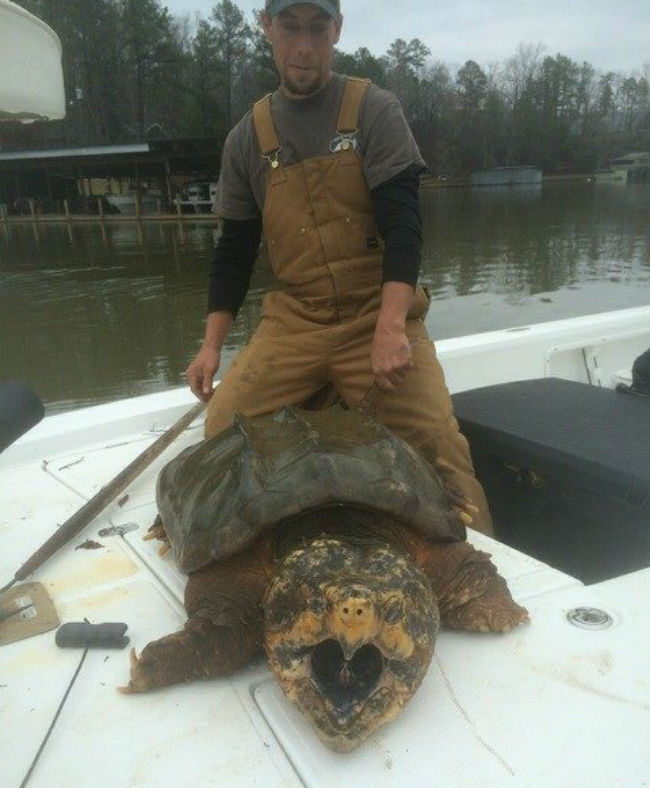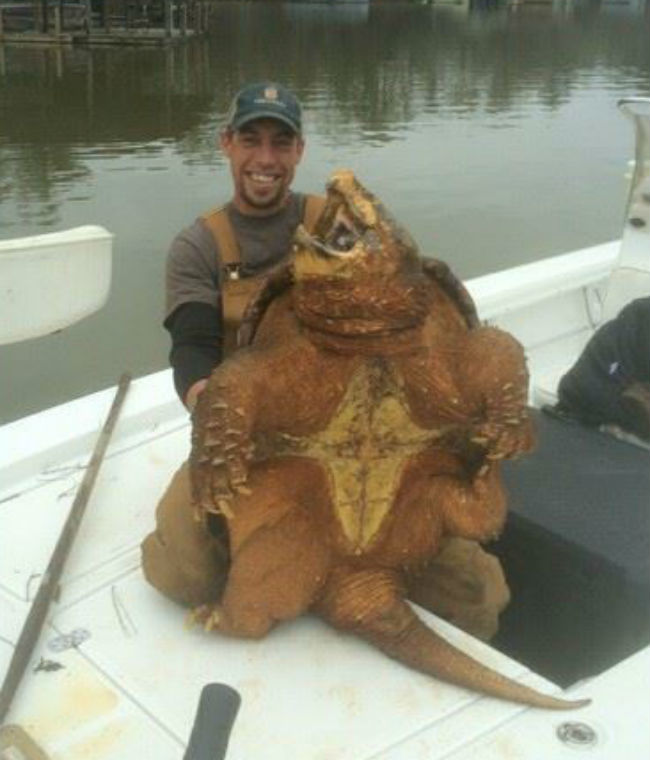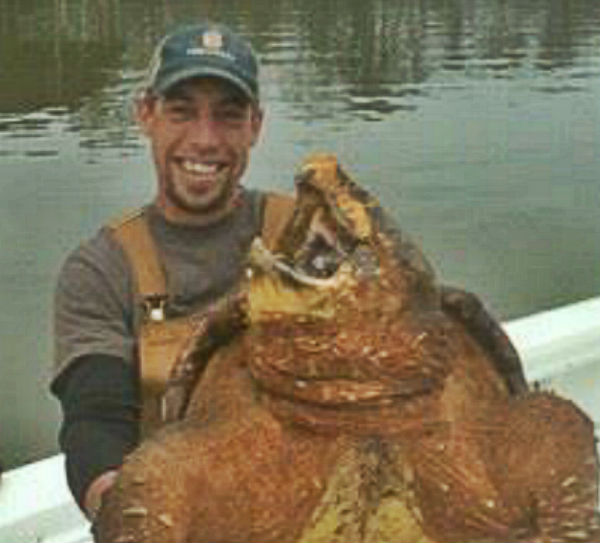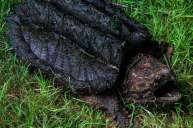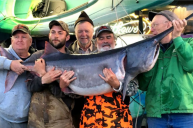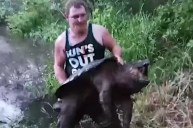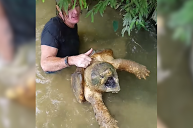An Alabama fisherman got the surprise of a lifetime when he found that instead of a log, he had actually hooked a gigantic alligator snapping turtle.
This post was originally published in December, 2018.
What started out as a typical morning of checking catfishing lines quickly turned into anything but an ordinary day for Wes Prewett. Prewett was running his boat on the Coosa River, a tributary of the Alabama River, from limb line to limb line, checking for catfish.
When the Canton resident came to one particular line he found something peculiar about his rig. Little did he know that he'd hooked a giant alligator snapping turtle.
Talking to Wes Prewett was a treat. A humble and respectful man, Prewett has recounted this story to many people many different times, but his enthusiasm and excitement in telling the tale is as fresh as the first time.
The limb line rig, which Prewett refers to as 'bush hooks,' is a tried and true catfish catching method popular in the South. It is a setup where the angler ties a length of heavy construction line to an overhanging bush or tree limb, attaches a baited hook and drops it into the water. The lines are left overnight, not unlike a trotline, and are checked the next morning for fish.
When Prewett came to this particular rig he noticed that the limb his line was attached to was almost submerged in the water. Normally, Prewett rigs his lines to a stout limb hanging several feet above the water. This one was extremely bent down into the water.
At first he thought that the dam had been opened and water had been released into the river, bringing with it all sorts of debris. The limb wasn't moving—a telltale sign of a hooked catfish—and he thought he had hooked a big log that had gotten stuck on the river bottom.
"I didn't know what was going on with it," Prewett recalled. "When I pulled up to it the whole limb was down towards the water, it was almost in the water, the limb itself was. Normally I use a limb that's three or four feet above the water. My first thought was that they had opened the dam up and released some water, and a log had floated in there and hooked the line. I thought it was just hooked on the bottom, to a log or something."
Prewett tugged on the line and it didn't budge. So he wrapped it around his arm with the intent of pulling hard to try to break the hook. He yanked and something gave. He thought he had broken a heavy limb of of the submerged log.
"I felt it break loose and I thought I broke a limb off of a tree, because it was heavy," he said.
As it neared the surface Prewett realized that something was up. A critter's head appeared at the surface of the water, but it was so large and odd-looking that it didn't immediately register as a turtle to Prewett.
A friendly prank?
"I ran those lines before work, so it was right at daybreak. And when that head popped up, at the crack of dawn, I'm thinking, 'Man, someone has tied this head on my line and is messing with me.' So I let it go back in the water, thinking someone's going to pop out from behind a tree and start laughing at me!"
Suddenly the supposed prank began moving away from Prewett. "It started moving, and I went, 'Shoot, that thing's alive!'" he told me. "I grabbed ahold of it again, and I tried to pull it back up. It hung on the bottom again and it started moving. He was crawling on the bottom. He started pulling the boat around, so I just wrapped the line around the cleat on the boat. It had some power, you know."
"Finally I got its head back up," Prewett recounted. "So I reached over and I grabbed the gaff hook out of the rod holder. I stuck that down in the water and I felt its shell. I knew it was a turtle as soon as its head popped up the second time. So I knew it was a big turtle, but I had no idea how big it was. I just saw its head and it was bigger than my head."
"I felt down around that shell with the gaff hook and I hooked the backside of his shell, on the butt end. Then I pulled it up and his tail came out of the water. He was thrashing around. I let go of the line that was coming out of his mouth. He had swallowed the string. It was way down in his throat."
Prewett continued, "His tail came up out of the water, so I let go of the line and reached over and grabbed his tail. Shoot, that thing [tail] was as long as my leg and bigger around than a baseball bat. So I had ahold of his tail, and he started thrashing around and trying to swim away. I started to pull him into the boat. I was going to put him on the front deck and take a picture of him, but I couldn't get him in the boat. He was so big."
Boating a dinosaur
Prewett continued: "He [the turtle] was right-side up when I tried to pull him in the boat, and his back legs hooked the edge of the boat and he was just not coming in. I had no power compared to this thing. I thought about it for a second and I thought if I can push him back down into the water and flip him over, then I can let his shell ride up into the boat. So that's what I did. I plunged it back down into the water really fast, and I flipped him over, and I pulled it up again and I let his shell ride up the side of the boat."
That's when things got interesting.
"When I pulled it in," Prewett said excitedly, "my feet slipped, cuz the boat deck was wet. That turtle landed on me down in the bottom of the boat!"
"I slid out from under it real quick, and it was popping its jaws trying to get me. That thing was ornery!"
Alligator snapper biology
Alligator snappers are indeed the dinosaur of the turtle world, and can grow to huge proportions. Alligator snapping turtles (Macrochelys temminckii) have powerful jaws and a hooked, beak-like mouth that can deliver a bite force of 1,000 psi. That's more than enough to remove a couple of fingers or do some severe damage if it bites you somewhere else. By comparison, the much larger American alligator can deliver a bite force of around 2,500 psi.
Alligator snappers primarily inhabit the waters of the southeastern United States. They are found in rivers that flow into the Gulf of Mexico, from the Florida Panhandle west to Eastern Texas, in oxbow lakes and slow moving sloughs in Kansas, Missouri, Mississippi, Georgia, Arkansas and Louisiana, in parts of Indiana, Kentucky and Tennessee, and as far north as the Mississippi River drainage in Iowa and Illinois.
Opportunistic feeders, they are primarily carnivorous although they do also consume some vegetable matter. Their diet includes snakes, fish, turtles, small alligators, and even aquatic mammals like muskrats and beavers.
They also have a worm-like appendage on their tongue which they use to lure small prey. They will sit motionless on the bottom of a lake or river, mouth agape with their worm-like tongue enticing potential prey. A successful hunt concludes with them snapping their strong beaks over their prey with great force and speed.
Alligator snappers can grow to impressive size. With a carapace length of more than 30 inches and weights that can surpass 200 pounds, they are the largest freshwater turtle in North America. Generally, only the males reach these gargantuan sizes, while the females rarely exceed 50 pounds. An unverified monster was found in Kansas in 1937 that purportedly weighed 403 pounds.
Their shells are defined by three rows of pronounced boney spikes or ridges. They are a rough-looking customer, no doubt about it.
Habitat loss and over-harvest in the 1970s has placed the alligator snapping turtle on threatened species lists in several states. But other states still have sustainable numbers and regulations that define their harvest and allowable quotas. Their endangered species status is currently listed as 'under review' by the USFWS.
Back to Prewett's monster snapper
It so happened that when Prewett flipped the big turtle into his bay boat it fit perfectly in the space between the console and the front deck. It kind of wedged itself in there, on its back, and didn't have enough space to flip itself right-side-up.
So Prewett fired up the engine and motored over to his friend Danny Jones' house. Jones owned the boat, and was outside when Prewett hollered at him from the water.
"I hollered at him," Prewett said. "I yelled, 'You're not going to believe what I just caught and what I got in the boat!' He said, 'What'd you get, a big catfish?' I said, 'You're not going to believe this. Come here!' He walked over to the edge of the boat and said 'What is that?! Get that out of my boat!' (laughing) I said 'Hang on. Help me take a picture of this thing. I can't believe it. I've never seen a turtle this big in my life!'"
So Jones took a few pictures as Prewett stood behind and held the turtle. He admitted that some of the photos didn't turn out because as he held the turtle upright it kept trying to bite his face off.
"I was kind of pushing its shell away from my face," Prewett said. "At first his feet started moving, then his tail moved, and all of a sudden his head and neck came out about three feet and he snapped his jaws at my head. It passed my face by just an inch or so!"
"He almost got me. That would've been a bad day if he'd have got me."
I asked Prewett if he was able to weigh the beast.
"Well we attempted to weigh it. It broke a 100-pound electronic fish scale. It bottomed the scale out like it was nothing," he said. "There was no way we could do it because the turtle was just too aggressive."
He added, "It was on the news, and Alabama Outdoor magazine and a bunch of different magazines. A gentleman from Auburn University contacted me. A herpetologist. He asked me how much I weighed, how tall I was, he made me measure my hand... He scaled my measurements to the turtle, and he estimated the turtle to be over 200 pounds and over 100 years old."
Release or donate
Alabama is one of the states that protects the alligator snapping turtle from harvest. Prewett had no interest in keeping the big reptile anyway. He just wanted a photograph, but another thought crossed his mind:
"Danny and I talked about it for a minute. I thought of the Birmingham Zoo over here in Alabama," he said. "We talked about calling them to see if they wanted to put it in the zoo. But I was running late for work. And I just thought I don't have time to mess with this. I now wish I had done something with it with the zoo."
So that meant his next move was to release the beast back into the river.
"The neighbors came over and saw it. I said I've got to get to work so I've got to put this thing back in the river. And everyone was like 'Don't put it back here! Don't let it go here!' (laughter) Everybody swims right there. It's a community swimming hole. So Danny told me to take it out to the main channel on the other side of the river to release it. So that's what I did."
"I grabbed its tail and flipped it up on the top deck, and it crawled off the edge of the boat. I put it in the shallows, where it was grassy. It crawled off in the water and it left a bubble trail like you wouldn't believe. He was making some time. It left a bubble trail right back to that slough where I caught it."
What monsters are hiding beneath the water?
As if this one gigantic snapping turtle wasn't the catch of a lifetime, Prewett beat it a couple months later...almost.
"About two months later I was fishing in a different slough," he recalled, "and I caught another one that was maybe twice as big as that one. I'm telling you, it was big! I tried to pull it up and I was fumbling around trying to get my phone out, because I knew I couldn't get that one into the boat. It was the size of a truck hood! I'm telling you this thing was huge!"
"It was thrashing around and it cut the line, it bit the line in two and it took off."
"Their beak, their mouth, is like a razor blade. It's sharp. The one that I took over to Danny's house was very aggressive. Danny put a wooden boat paddle by its mouth, and it bit the wooden boat paddle into three pieces."
Good thing it didn't get ahold of Prewett when he took that picture or when it fell on top of him in the boat. In any event, it surely is the catch of a lifetime, and will no doubt make for countless great future stories.
"I've never experienced anything like that in my life," Prewett concluded.
For all your fishing gear needs, check out Bass Pro Shops.
Like what you see here? Experience more articles and photographs about the great outdoors at the Facebook page, Stumpjack Outdoors.
NEXT: I TRIED INCUBATING AND HATCHING SNAPPING TURTLE EGGS. HERE'S WHAT HAPPENED.
WATCH
